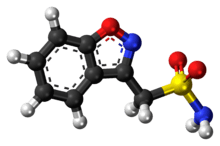Zonisamide
 | |
 | |
| Clinical data | |
|---|---|
| Trade names | Zonegran |
| AHFS/Drugs.com | Monograph |
| MedlinePlus | a603008 |
| Pregnancy category | |
| Routes of administration | Oral |
| ATC code | N03AX15 (WHO) |
| Legal status | |
| Legal status | |
| Pharmacokinetic data | |
| Bioavailability | ~100%[1] |
| Protein binding | 40%[1] |
| Metabolism | Hepatic through CYP3A4[1] |
| Biological half-life | 63 hours in plasma[1] |
| Excretion | Renal (62%); Faeces (3%)[1] |
| Identifiers | |
| |
| CAS Number |
68291-97-4 |
| PubChem (CID) | 5734 |
| IUPHAR/BPS | 7047 |
| DrugBank |
DB00909 |
| ChemSpider |
5532 |
| UNII |
459384H98V |
| KEGG |
D00538 |
| ChEBI |
CHEBI:10127 |
| ChEMBL |
CHEMBL750 |
| PDB ligand ID | ZON (PDBe, RCSB PDB) |
| ECHA InfoCard | 100.118.526 |
| Chemical and physical data | |
| Formula | C8H8N2O3S |
| Molar mass | 212.227 g/mol |
| 3D model (Jmol) | Interactive image |
| Melting point | 162 °C (324 °F) |
| |
| |
| (verify) | |
Zonisamide is a sulfonamide anticonvulsant approved for use as an adjunctive therapy in adults with partial-onset seizures; infantile spasm, mixed seizure types of Lennox–Gastaut syndrome, myoclonic, and generalized tonic clonic seizure.[2]
Medical uses
Epilepsy
Zonisamide is approved in the United States,[3] United Kingdom,[4] and Australia[5] for adjunctive treatment of partial seizures in adults and in Japan for both adjunctive and monotherapy for partial seizures (simple, complex, secondarily generalized), generalized (tonic, tonic-clonic (grand mal), and atypical absence) and combined seizures.[6] For epilepsy, most studies have used oral zonisamide in daily doses ranging from 200 to 600 milligrams/day, divided in 2 daily doses, adjusted to maintain serum levels of 15 to 40 micrograms/milliliter[7][8][9][10]
Tardive dyskinesia
In an open-label trial zonisamide attenuated the symptoms of tardive dyskinesia.[11]
Obesity
It has also been studied for obesity[12] with significant positive effects on body weight and there are three ongoing clinical trials for this indication.[13][14][15] It is to be sold, when combined with bupropion, under the brand name Empatic.
Migraine
Zonisamide has been studied for and used as a migraine preventative medication, and has also been shown to be effective in some cases of neuropathic pain.
Bipolar depression
It has also been used off-label by psychiatrists as a mood stabilizer to treat bipolar depression.[16][17]
Adverse effects
Adverse effects by incidence:[1][18][19]
Very common (>10% incidence) adverse effects include:
- Anorexia
- Somnolence
- Dizziness
- Agitation
- Irritability
- Confusional state
- Depression
- Diplopia
- Memory impairment
- Decreased bicarbonate
Common (1-10% incidence) adverse effects include:
- Ecchymosis
- Hypersensitivity
- Affect lability
- Anxiety
- Insomnia
- Psychotic disorder
- Bradyphrenia
- Disturbance in attention
- Nystagmus
- Paraesthesia
- Speech disorder
- Tremor
- Abdominal pain
- Constipation
- Diarrhoea
- Dyspepsia
- Nausea
- Rash
- Pruritus
- Alopecia
- Nephrolithiasis
- Fatigue
- Influenza-like illness
- Pyrexia
- Oedema peripheral
- Weight loss
Interactions
Zonisamide and other carbonic anhydrase inhibitors such as topiramate, furosemide, and hydrochlorothiazide have been known to interfere with amobarbital, which has led to inadequate anesthetization during the Wada test.[20] Zonisamide may also interact with other carbonic anhydrase inhibitors to increase the potential for metabolic acidosis.[1]
Additionally, the metabolism of zonisamide is inhibited by ketoconazole, ciclosporin, miconazole, fluconazole and carbamazepine (in descending order of inhibition) due to their effects on the CYP3A4 enzyme.[21]
Mechanism of action
Zonisamide is an antiseizure drug chemically classified as a sulfonamide and unrelated to other antiseizure agents. The precise mechanism by which zonisamide exerts its antiseizure effect is unknown, although it is believed that the drug blocks sodium and T-type calcium channels, which leads to the suppression of neuronal hypersynchronization (that is, seizure-form activity).[5] It is also known to be a weak carbonic anhydrase inhibitor (similarly to the anticonvulsant, acetazolamide). It is also known to modulate GABAergic and glutamatergic neurotransmission.[5][22][23][24][25]
Pharmacokinetics
Absorption
Variable, yet relatively rapid rate of absorption with a time to peak concentration of 2.8-3.9 hours. Food has no effect on the bioavailability of zonisamide[26]
Metabolism
Zonisamide is metabolized mostly by the CYP3A4 isoenzyme, but also CYP3A7 and CYP3A5,[27] to 2-(sulphamoylacetyl)-phenol via reductive cleavage of the 1,2-benzisoxazole ring.[28]
History
Zonisamide was discovered by Uno and colleagues in 1972[29] and launched by Dainippon Sumitomo Pharma (formerly Dainippon Pharmaceutical) in 1989 as Excegran in Japan.[30] It was marketed by Élan in the United States starting in 2000 as Zonegran, before Élan transferred their interests in zonisamide to Eisai Co., Ltd. in 2004.[31] Eisai also markets Zonegran in Asia (China, Taiwan, and fourteen others)[32] and Europe (starting in Germany and the United Kingdom).[33]
References
- 1 2 3 4 5 6 7 "Zonegran® Product Information" (PDF). TGA eBusiness Services. SciGen (Australia) Pty Ltd. 4 April 2013. Retrieved 18 November 2013.
- ↑ Comprehensive Pharmacy Review, Leon Shargel, 6th edition, p988
- ↑ Élan Pharmaceuticals Inc (22 August 2003). "NDA 20-789/S-001; Zonegran (zonisamide) Capsules 25, 50, 100 mg FDA Approvable Labeling Text" (PDF). Zonisamide Approval History. Food and Drug Administration. Retrieved 24 August 2009.
- ↑ Eisai Ltd. (2005). "Zonegran Summary of Product Characteristics". electronic Medicines Compendium. Medicines.org.uk. Retrieved 13 November 2005.
- 1 2 3 Rossi, S, ed. (2013). Australian Medicines Handbook (2013 ed.). Adelaide: The Australian Medicines Handbook Unit Trust. ISBN 978-0-9805790-9-3.
- ↑ Dainippon Pharmaceutical Co., Ltd. (2004). "EXCEGRAN Tablets 100 mg & EXCEGRAN Powder 20%" (PDF). Retrieved 13 March 2006.
- ↑ Shimizu A, Ikoma R, & Shimizu T: Effects and side effects of zonisamide during long-term medication. Curr Ther Res 1990; 47:696-706
- ↑ Iinuma K, Handa I, Fueki N, et al: Effects of zonisamide (AD-810) on refractory epilepsy in children: special reference to temporal lobe abnormalities. Curr Ther Res 1988; 43:281-282
- ↑ Sakamoto K, Kurokawa T, Tomita S, et al: Effects of zonisamide in children with epilepsy. Curr Ther Res 1988; 43:378-383
- ↑ Shimizu A, Yamamoto J, Yamada Y, et al: The antiepileptic effect of zonisamide in patients with refractory seizures. Curr Ther Res 1987; 42:147-155
- ↑ Iwata, Y; Irie, S; Uchida, H; Suzuki, T; Watanabe, K; Iwashita, S; Mimura, M (15 April 2012). "Effects of zonisamide on tardive dyskinesia: a preliminary open-label trial". Journal of the Neurological Sciences. 315 (1-2): 137–140. doi:10.1016/j.jns.2011.12.010. PMID 22285275.
- ↑ Gadde, Kishore M.; Franciscy, Deborah M.; Wagner, II, H. Ryan; Krishnan, K. Ranga R. (April 2003). "Zonisamide for Weight Loss in Obese Adults: A Randomized Controlled Trial". Journal of the American Medical Association. 289 (14): 1820–1825. doi:10.1001/jama.289.14.1820. PMID 12684361.
- ↑ University of Cincinnati (2005). "Zonegran in the Treatment of Binge Eating Disorder Associated With Obesity". ClinicalTrials.gov. Retrieved 2006-05-04.
- ↑ Tuscaloosa Research; Education Advancement Corporation (2005). "Zonegran for the Treatment of Weight Gain Associated With Psychotropic Medication Use: A Placebo-Controlled Trial". ClinicalTrials.gov. Retrieved 2006-05-04.
- ↑ National Institute of Diabetes and Digestive and Kidney Diseases (NIDDK) (2006). "Zonisamide for Weight Reduction in Obese Adults". ClinicalTrials.gov. Retrieved 2006-05-04.
- ↑ Brian D. Loftus (2004). "Zonegran". Retrieved 2006-11-29.
- ↑ Hasegawa, Hisanori (May 2004). "utilization of zonisamide in patients with chronic pain or epilepsy refractory to other treatments: a retrospective, open label, uncontrolled study in a VA hospital". Curr Med Research Opinion. 20 (5): 577–580. doi:10.1185/030079904125003313. PMID 15140322.
- ↑ "Zonegran 25, 50, 100 mg Hard Capsules". electronic Medicines Compendium. Eisai Ltd. 8 October 2013. Retrieved 18 November 2013.
- ↑ "zonisamide (Rx) - Zonegran". Medscape Reference. WebMD. Retrieved 18 November 2013.
- ↑ Bookheimer, Susan; Schrader, Lara M.; Rausch, Rebecca; Sankar, Raman; Engel, Jerome Jr. (February 2005). "Reduced anesthetization during the intracarotid amobarbital (Wada) test in patients taking carbonic anhydrase-inhibiting medications". Epilepsia. 46 (2): 236–43. doi:10.1111/j.0013-9580.2005.23904.x. PMID 15679504.
- ↑ Nakasa, H.; Nakamura H; Ono S; Tsutsui M; Kiuchi M; Ohmori S; Kitada M. (April 1998). "Prediction of drug-drug interactions of zonisamide metabolism in humans from in vitro data". European Journal of Clinical Pharmacology. 54 (2): 177–83. doi:10.1007/s002280050442. PMID 9626925.
- ↑ Leppik, Ilo E. (December 2004). "Zonisamide: chemistry, mechanism of action, and pharmacokinetics". Seizure. 13 (Suppl 1): S5–9; discussion S10. doi:10.1016/j.seizure.2004.04.016. PMID 15511691.
- ↑ Mimaki, T; Suzuki, Y; Tagawa, T; Karasawa, T; Yabuuchi, H (March 1990). "Interaction of zonisamide with benzodiazepine and GABA receptors in rat brain". Medical Journal of Osaka University. 39 (1-4): 13–7. PMID 1369646.
- ↑ Mimaki, T; Suzuki, Y; Tagawa, T; Karasawa, T; Yabuuchi, H (March 1990). "[3H]zonisamide binding in rat brain". Medical Journal of Osaka University. 39 (1-4): 19–22. PMID 1369647.
- ↑ Ueda, Y; Doi, T; Tokumaru, J; Willmore, J (2003-08-19). "Effect of zonisamide on molecular regulation of glutamate and GABA transporter proteins during epileptogenesis in rats with hippocampal seizures". Molecular Brain Research. 116 (1-2): 1–6. doi:10.1016/S0169-328X(03)00183-9. PMID 12941455.
- ↑ http://www.drugbank.ca/drugs/DB00909
- ↑ Ohmori, S.; Nakasa H; Asanome K; Kurose Y; Ishii I; Hosokawa M; Kitada M (1998-05-08). "Differential catalytic properties in metabolism of endogenous and exogenous substrates among CYP3A enzymes expressed in COS-7 cells". Biochimica et Biophysica Acta. 1380 (3): 297–304. doi:10.1016/s0304-4165(97)00156-6. PMID 9555064.
- ↑ Stiff, D. D.; Robicheau JT; Zemaitis MA. (January 1992). "Reductive metabolism of the anticonvulsant agent zonisamide, a 1,2-benzisoxazole derivative". Xenobiotica. 22 (1): 1–11. doi:10.3109/00498259209053097. PMID 1615700.
- ↑ Shah J, Kent Shellenberger, Daniel M. Canafax (2002-06-15) [1972]. "Zonisamide". In René H, Levy RH, Brian SM, Perrucca E. Antiepileptic Drugs (Fifth ed.). Philadelphia: Lippincott Williams & Wilkins. p. 873. ISBN 0-7817-2321-3. Retrieved 2007-11-07.
- ↑ Dainippon Sumitomo Pharma Co. Ltd. (2005). "Company History". Company Information. Dainippon Sumitomo Co., Ltd. Archived from the original on 13 February 2006. Retrieved 12 November 2005.
- ↑ Dainippon Pharmaceutical Co. Ltd. (2004). "Transfer of Rights Agreement for North America and Europe Reached on Zonegran". News Releases for Dainippon Pharmaceutical in 2004. Dainippon Sumitomo Pharma Co., Ltd. Archived from the original on 13 February 2006. Retrieved 12 November 2005.
- ↑ Dainippon Pharmaceutical Co. Ltd. (2005). "Dainippon Pharmaceutical and Eisai Conclude Agreement for the Development, Manufacture and Marketing of the Anti-Epileptic Agent Zonisamide in Asia". Dainippon Pharmaceutical News Releases for 2005. Dainippon Sumitomo Pharma Co., Ltd. Archived from the original on 22 February 2006. Retrieved 12 November 2005.
- ↑ Eisai Co. Ltd. (2005). "Eisai Announces Launch of Zonegran (zonisamide), Treatment For Epilepsy In the UK and Germany". Eisai 2005 News Releases. Eisai Co., Ltd. Retrieved 12 November 2005.
External links
- Official Eisai Website
- Dainippon Sumitomo Prescribing Information for Excegran (Japanese version)
- Official Dainippon Sumitomo Pharma Website (English version)